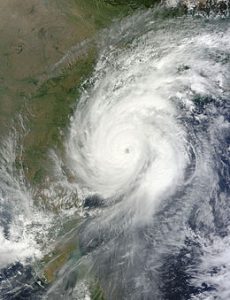Tropical Storms
By Michael FaginMt. Everest Weather Forecasting, Trekking Everest, Trekking Nepal
The 2016 North Indian Ocean Cyclone Season
The three names for tropical storms, hurricanes, typhoons and cyclones all refer to storms with the same characteristics and can bring harm to climbers and others. The titles reflect regional differences in describing the same phenomena. Hurricanes originate in the Atlantic Basin. Typhoons in the Pacific and Cyclones in the Indian Ocean.
In this instance we want to examine the current cyclone season affecting the Indian Subcontinent and the Himalayas. To date there have been three cyclonic events. The first and thus far worst storm has been Cyclone Roanu which developed 17 May in the Bay of Bengal. This storm came ashore near Chittagong, Bangladesh and resulted in the loss of 227 lives and 1.7 Billion USD in damage. This storm marked the beginning of the 2016 tropical cyclone season.
The second storm, known as ARB-1, jargon for the first storm in the Arabian Sea, diminished quickly becoming a rain event for Oman.
The third storm, that recently formed, was a Deep Depression in the Bay of Bengal. To date, no known losses have been tallied although a number of fishing trawlers had gone missing. Good work by the Indian Coast Guard located all the boats with one having been in distress due to an engine malfunction. This storm has brought considerable rain into West Bengal and the Kolkata region.
For mountaineers and trekkers in the Himalayas these storms can presage weather conditions which can be quite fierce. In 2014, Cyclone Hud Hud, brought heavy snows and rain to the Annapurna region which caught several hundred trekkers on the trails. 43 people were lost with hundreds injured. Avalanches, slides, trail and bridge wash outs contributed to the totals. In a region with fragile infrastructure disruptions of trails can be catastrophic.
The Annapurna Circuit Trek is one of the highest treks available on a regular basis for both experienced and newcomers alike. Crossing the Thorong La Pass, the highest pass along the circuit the high winds are well documented. It was this area where many lives were lost in the 2014 tragedy. A combination of orographic lift and local geography turned the pass into a wind tunnel bringing snow, rain and the resulting avalanches down on unsuspecting travelers.
Each region of the planet uses a slightly different scale and nomenclature for describing tropical storms. The North Atlantic for example uses the Saffir-Simpson Scale of Depression through Category 5. This varies from light winds to wind speeds of 154 miles per hour and higher.
The North Indian Ocean Scale ranges from depression and light winds through the Super Cyclonic System which ranges to the 154 miles per hour scale. There are some over laps in wind speed ranges which are not relevant
in any meaningful way to most people.
Consistent weather data for the region is available dating from 1890 and shows the progression of accuracy in collection. It is also worth noting that airborne particulates may be contributing to the cyclonic events although no known studies have proven a direct relationship.
For climbers and trekkers in the Himalayas staying aware of tropical storm developments, especially in the Bay of Bengal can affect the quality and safety of the expedition. Mountain travel, especially at Himalayan elevations is very challenging in good weather. Being caught out between inns along the Annapurna circuit route is life threatening. Good gear and experienced guides are essential.
The Nepali government has made great strides in weather forecasting but given the natural disasters of recent years there are still gaps in coverage. Weather awareness is a critical for a safe and positive experience. Finally using a professional forecast service to give advanced cyclone warnings delivered to your phone is a great feature we provide.
Written by Bob Morthorst and edited by Operational Meteorologist Michael Fagin
